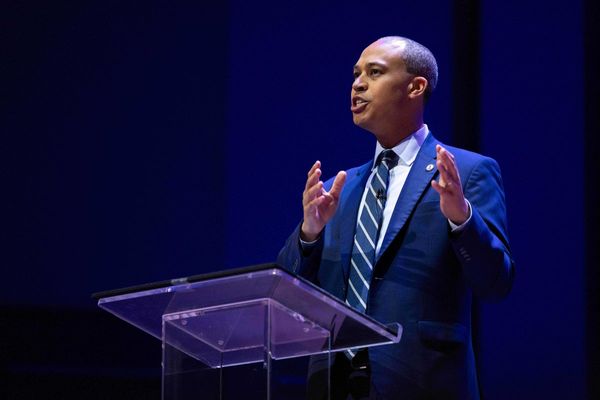The consumer price index rose less than expected in May, as the overall inflation rate continued to fall. But core CPI inflation, excluding prices for energy and groceries, matched forecasts, remaining way too hot for the Federal Reserve. The S&P 500 pushed higher early Tuesday, after closing at a 13-month peak on Monday, as Wall Street awaits guidance about the rate-hike outlook at Wednesday's Fed meeting.
CPI Inflation Report Hits And Misses
The CPI inflation rate fell to 4.0%. Economists had expected the inflation rate to ease to 4.1% from 4.9% in April. The consumer price index rose 0.1% on the month, below 0.2% forecasts.
The core CPI rose 0.4% vs. April levels, as expected. The annual core inflation rate dipped to 5.3% from 5.5% in April, matching forecasts. The core CPI inflation rate peaked at a 40-year-high 6.6% in September.
Fed Chair Jerome Powell has said that the most important category of spending for the inflation outlook is core nonhousing services, reported with the Commerce Department's late-month personal income and outlays data. Wall Street looks to the CPI gauge of services less rent of shelter as a reasonably close proxy, though it has serious shortcomings.
May's CPI showed services less rent of shelter prices slipped 0.2% on the month after a slim 0.1% rise in April. The year-over-year gain slipped to 4.2% from 5.2% in April. However, a 0.1% drop in the cost of medical care services distorted the monthly figure. That partly reflected a 3.7% monthly drop in the cost of health insurance. But the CPI report's methodology focused on health insurer profits from the previous year doesn't yield a timely, useful data point.
Fed Policy Impact
Ahead of the CPI report, markets were pricing in about 23% odds of a quarter-point Fed rate hike on Wednesday, but that fell to 7% after the inflation data. Rate-hike odds for the Fed's July 26 policy update eased to 65% from about 73% before the CPI report.
The CPI report reinforced expectations of a June pause, almost 100% locked in. But it didn't significantly alter the outlook for July rate hike.
Powell has said that hiking interest rates by five percentage points since March 2022 gives the Fed "luxury" to wait and see how the data develops. But unless inflation and the job market show more pronounced softening by the July meeting, another hike seems likely.
Fed Decision On Tap; What Investors Need Now
CPI Report Details
Core goods prices jumped 0.6% for the second straight month, leaving the 12-month core goods inflation rate at 2%.
Energy prices slid 3.6% on the month and are down 11.7% from a year ago.
Inflation for food served at home continued to moderate, as prices edged up 0.1% in May after falling 0.2% and 0.3% the prior two months. Prices are up 5.8% from a year ago, down from 7.1% in April.
Food away from home prices, which tend to be more affected by labor costs, rose 0.5% on the month and 8.3% from a year ago.
The CPI report showed used car prices jumping 4.4% for a second straight month, but economists expect that to reverse soon. New vehicle prices dipped 0.1%, but they're still up 4.7% from a year ago.
Apparel prices rose 0.3% and are now up 3.5% from a year ago.
Transportation services prices rose 0.8% after April's 0.2% decline. Prices for shelter rose 0.6%, following April's 0.4% gain. The year-over-year gain eased slightly to 8%.
S&P 500 Reaction To CPI Report
After the CPI report, the S&P 500 rose 0.65% in Tuesday stock market action, hitting its highest levels since April 2022.
The S&P 500's climb of more than 20% off October's bear-market low means we're in a new bull market. Stock market history would suggest more gains will follow over the next year, though a potential recession could create quite a detour. On top of a likely additional rate hike, the S&P 500 also will have to withstand the contrary tide of Federal Reserve quantitative tightening and a surge in Treasury issuance.
Be sure to read IBD's The Big Picture every day to stay in sync with the market direction and what it means for your trading decisions.
CPI Proxy For Core Nonhousing Services
It is possible to construct an inflation index out of the CPI that bears some relation to the core nonhousing services category highlighted by Powell.
Start with services less rent of shelter. Subtract energy services and health insurance (which is derived from last year's health insurer profits). Then add lodging and food services. In May, the CPI proxy for core nonhousing services saw prices rise a moderate 0.2%, following April's 0.3%. On a 3-month annualized basis, the inflation rate eased to 3.9% from 5.6% in April.
Still, this CPI category covers just over 29% of consumer outlays, while PCE core nonhousing services covers about 50% of household spending. In other words, there are still huge differences. Health care is a glaring one, since it accounts for nearly 16% of PCE spending, while medical services amounts to less than 7% of CPI budgets.
The best clue to PCE health services inflation won't come from the CPI but from Wednesday's producer price index. The PPI medical services component feeds directly into the PCE.







